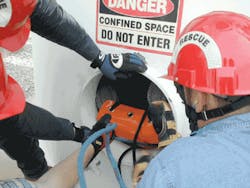Twice a year, OSHA publishes a regulatory agenda as a way to keep the regulated community informed regarding upcoming activity. The latest edition was issued in July 2013 and includes a list of 26 rules in various stages of development as well as milestones scheduled for completion in 2013.
While the progress on these OSHA rules is hypnotizingly slow, it is important to stay informed because OSHA offers the regulated community the opportunity to provide feedback and input during the rulemaking process. The agency also provides extensive supporting analysis – mandated by Congress – that can help an EHS manager get a head start on assessing his or her organization's readiness for these new or changing rules. The following are summaries of three rules that OSHA is working on that should be considered when planning for 2014 and beyond.
Combustible Dust (RIN: 1218-AC41)
In a study conducted in 2006, the Chemical Safety Board documented hundreds of fatalities and serious injuries resulting from combustible dust explosions. As a result, OSHA began working on this rule in October 2009 with the release of an advanced notice of proposed rulemaking.
Any workplace where combustible dust is generated and allowed to accumulate over time is at increased risk of a serious fire or explosion. Some of the workplaces identified by OSHA that will be affected by this rule include those that process wood, paper and food products (especially sugar and grains); those that process plastics; pharmaceutical manufacturers; and any business that stores and processes coal.
The Small Business Regulatory Enforcement Fairness Act review was on the docket in November, one of the many steps to the rulemaking process that provide a detailed assessment of the anticipated economic impacts to small business resulting from this rule. While OSHA has not completed its economic evaluation for this rule, some stakeholders have expressed concern that some costs of the expected requirements (e.g., updating power-plant equipment to meet NFPA 654 specifications) could run in the millions of dollars per power plant. The release of a final rule for combustible dust could take up to five years, so this is the optimal time in the rulemaking process to provide input.
Occupational Exposure to Silica (RIN: 1218-AB70)
This proposed rule, published in September 2013, is in response to an increasing body of knowledge regarding the health effects associated with exposure to crystalline silica. While OSHA has regulated crystalline silica safety since the agency's inception in 1970, the lack of progress in making improvements to worker protection through means outside of the rulemaking process has been slow. In terms of benefits from the proposed rule, OSHA estimates that employers will save $2.8 billion in costs associated with a decrease in the number of employee fatalities and serious illnesses.
Of all the industries likely to be impacted by this new rule, hydraulic fracking gets the most press attention. Large quantities of sand containing crystalline silica are used as a component of the hydraulic fracking fluid that is used to stimulate oil and gas production in shale formations. Crystalline silica becomes airborne during the delivery and transfer of silica sand, thus exposing workers to crystalline silica through inhalation. Other industries that need to pay attention to this rule include foundries, dental labs, manufacturers of concrete products, roadway construction, masonry and mining.
OSHA estimates the average annualized cost of compliance once the revised rule is finalized will be $658 million, with the lion's share of the costs ($511 million) borne by the construction industry. While OSHA's analysis has concluded that there will be no significant adverse economic impact to small business, it is conceded that small businesses are at a disadvantage as they generally pay higher unit costs on items such as training and exposure monitoring services relative to their larger counterparts. While one-time capital investments in engineering controls are expected to cost the most, EHS managers should consider seeking engineering controls with the efficacy to reduce recurring costs such as respirators and exposure monitoring. With the publishing of the notice of proposed rulemaking in September 2013, OSHA typically estimates up to two years to collect and review feedback from the regulated community and up to three years to publish a final rule. Once the final rule is made effective, expect a two-year roll-out schedule.
Confined Spaces in Construction (RIN 1218-AB47)
OSHA was scheduled to publish a final rule for confined spaces in construction this month. Although OSHA has enforced a confined spaces standard applicable to general industry since 1993, none exists for the construction industry. Recognizing the material differences in managing the confined space hazard in a construction setting and further recognizing the need for a regulatory standard, OSHA published the proposed rule for confined spaces in construction in November 2007. As proposed, this rule will affect any construction company whose worksite has confined spaces – including residential and industrial builders, highway and street construction companies, water and sewer construction companies and utility and communications construction companies.
With the final rule due this month, EHS managers should begin accelerating their efforts to provide training to their affected workforce. There are many elements in the confined spaces in construction standard that fundamentally are different than the confined spaces for general industry, so it's not safe to assume that a workforce trained in the general industry standard is prepared for this new standard for the construction industry. For contractors who typically are in the role of controlling contractor, EHS managers should think strategically regarding the readiness of their subcontractor workforce.
What's Next?
OSHA publishes its regulatory agenda twice a year, with the next installment expected around press time for this magazine. The regulated community can expect to see the timing of the next steps along the path toward finalization of the three rules discussed above.
While our days normally are full with keeping up with all of the regulations that already are in effect, taking the time to track new rules in the making can help ensure that our organizations are ready once these new rules become finalized. The OSHA website provides plenty of tools for tracking progress of and providing input to the rulemaking process.
Ron Severson, CSP, MSM, is a senior consultant with TRC's Environmental Management & Sustainability Practice. He has over 20 years of experience as an EHS professional working in both consulting and the pharmaceutical industry. As a consultant, Severson's background includes extensive experience with EHS program development, assessments and audits, construction safety, industrial hygiene and indoor air quality services and human health risk assessment. Amy Boas, CIH, is a senior consultant with TRC's Environmental Management & Sustainability Practice. She has been an EHS professional in both consulting and private industry for 18 years. As a consultant, Boss has focused on management consulting, including EHS culture development, identifying and implementing corporate EHS-related objectives and sustainability, in addition to industrial hygiene assessments, EHS audits and EHS program development.

